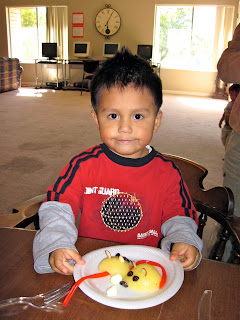 |
| Photo Credit |
- When appropriate, share your emotions with your child
- Children are learning about emotions by watching how you show yours
- Listen to your child for clues about what she is feeling
- Take your child's emotions seriously
- Be willing to understand your child's perspective
- Encourage your child to talk about feelings
- Listen to your child in a way that lets her know you are paying attention
- Try not to judge or criticize emotions that are different from what you expected
- Research shows that it is important to understand the emotion before you give advice on the behavior
- Start identifying emotions even before a child can talk
- talk about emotions like happy, sad, and angry and when people feel them
- Name a range of emotions. Talk about what these emotions mean and when people feel them
- avoid telling children what they ought to feel--try to identify the emotions they are feeling
- Model identifying your own emotions--children learn by watching and copying what adults do.
- When children misbehave, explain why their behavior was inappropriate or hurtful
- encourage emotional expression, but set limits on behavior
- Help children think through possible solutions
I chose this topic because I related to it. Looking back, my parents had to use emotion coaching on me a lot when I was a child. The most common emotion I had was crying. I cryed when I was sad, frustrated, upset, mad, scared... This could have been because of my many fears and anxieties I had. For one thing, I was very shy so whenever I was going to a party or to school or to any social situation I was nervous and if my anxiety built up enough I would start crying making it so I couldn't go to the party or other activity. Once I started to cry I started to cry harder. My Mom actually helped me understand that Icried harder because I felt embarrased or frustrated with myself for crying and so I would cry even more. When it was ok (I wasn't in a public place), my parents would just let me cry becasue they realized that my crying was my way of letting out my frustration. They would also never belittle my feelings (even though it was probably silly what I was crying over) and they always sit next to me asking me to tell them what is wrong, waiting patiently until I was ready to talk. If I couldn't explain my emotion, they would ask, "are you feeling this way because..." When finding solutions, it was really helpful when my parents were able to relate to what I was going through. If my crying lasted too long or too often, or I was making a scene in the public park my Mom would tell me to "stop crying". It may have taken a few times but I forced myself to try to stop crying (exercising mind over matter) especially so I would learn to handle my emotions in certain situations. Through this exercise I was able to hold my emotions to myself (during school so I wouldn't embarrase myself) until I got home because my parents taught me that home was a safe place to share my emotions.
Your going to find that every child is different and so will have different emotional needs. Hopefully my storytelling was helpful and these steps and serve as a helpful outline for you.

















































![[modge+podge+jars.jpg]](https://blogger.googleusercontent.com/img/b/R29vZ2xl/AVvXsEjSe_NT7S_YSxFjkBODOSiQzgo_uzUnExMZwrlnPlsphRF-RLLa97OUBT39PpQIjvUaicfljGrbQaFVqf2rGD6xkFS48D2WkDNEo0k3oXlWAGqgqKOucn51v_MzgSAEH_7Nhnfv61VTCvI/s320/modge+podge+jars.jpg)
